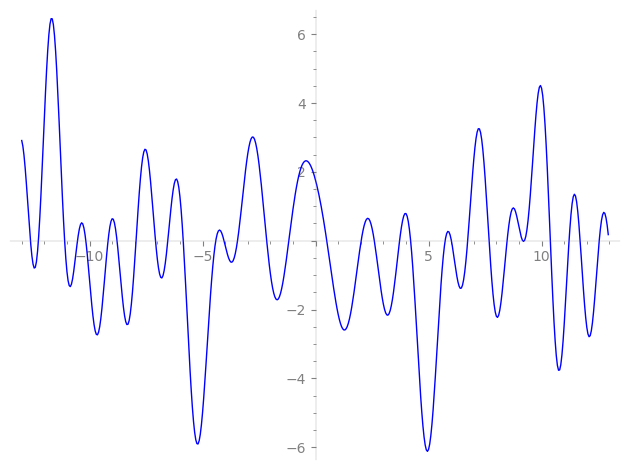| L(s) = 1 | + (0.866 + 0.5i)3-s + (−1.80 − 3.12i)7-s + (0.499 + 0.866i)9-s + (3 + 1.73i)11-s + (3.46 + i)13-s + (−1.73 + i)17-s + (−6.12 + 3.53i)19-s − 3.60i·21-s + (−4.54 − 2.62i)23-s + 0.999i·27-s + (−3.62 + 6.27i)29-s + 3.46i·31-s + (1.73 + 3i)33-s + (−3.60 + 6.24i)37-s + (2.49 + 2.59i)39-s + ⋯ |
| L(s) = 1 | + (0.499 + 0.288i)3-s + (−0.681 − 1.18i)7-s + (0.166 + 0.288i)9-s + (0.904 + 0.522i)11-s + (0.960 + 0.277i)13-s + (−0.420 + 0.242i)17-s + (−1.40 + 0.810i)19-s − 0.786i·21-s + (−0.947 − 0.546i)23-s + 0.192i·27-s + (−0.672 + 1.16i)29-s + 0.622i·31-s + (0.301 + 0.522i)33-s + (−0.592 + 1.02i)37-s + (0.400 + 0.416i)39-s + ⋯ |
\[\begin{aligned}\Lambda(s)=\mathstrut & 3900 ^{s/2} \, \Gamma_{\C}(s) \, L(s)\cr =\mathstrut & (0.206 - 0.978i)\, \overline{\Lambda}(2-s) \end{aligned}\]
\[\begin{aligned}\Lambda(s)=\mathstrut & 3900 ^{s/2} \, \Gamma_{\C}(s+1/2) \, L(s)\cr =\mathstrut & (0.206 - 0.978i)\, \overline{\Lambda}(1-s) \end{aligned}\]
Particular Values
| \(L(1)\) |
\(\approx\) |
\(1.755009538\) |
| \(L(\frac12)\) |
\(\approx\) |
\(1.755009538\) |
| \(L(\frac{3}{2})\) |
|
not available |
| \(L(1)\) |
|
not available |
\(L(s) = \displaystyle \prod_{p} F_p(p^{-s})^{-1} \)
| $p$ | $F_p(T)$ |
|---|
| bad | 2 | \( 1 \) |
| 3 | \( 1 + (-0.866 - 0.5i)T \) |
| 5 | \( 1 \) |
| 13 | \( 1 + (-3.46 - i)T \) |
| good | 7 | \( 1 + (1.80 + 3.12i)T + (-3.5 + 6.06i)T^{2} \) |
| 11 | \( 1 + (-3 - 1.73i)T + (5.5 + 9.52i)T^{2} \) |
| 17 | \( 1 + (1.73 - i)T + (8.5 - 14.7i)T^{2} \) |
| 19 | \( 1 + (6.12 - 3.53i)T + (9.5 - 16.4i)T^{2} \) |
| 23 | \( 1 + (4.54 + 2.62i)T + (11.5 + 19.9i)T^{2} \) |
| 29 | \( 1 + (3.62 - 6.27i)T + (-14.5 - 25.1i)T^{2} \) |
| 31 | \( 1 - 3.46iT - 31T^{2} \) |
| 37 | \( 1 + (3.60 - 6.24i)T + (-18.5 - 32.0i)T^{2} \) |
| 41 | \( 1 + (-6.24 - 3.60i)T + (20.5 + 35.5i)T^{2} \) |
| 43 | \( 1 + (-7.14 + 4.12i)T + (21.5 - 37.2i)T^{2} \) |
| 47 | \( 1 - 10.6T + 47T^{2} \) |
| 53 | \( 1 - 9.24iT - 53T^{2} \) |
| 59 | \( 1 + (-4.62 + 2.66i)T + (29.5 - 51.0i)T^{2} \) |
| 61 | \( 1 + (-30.5 + 52.8i)T^{2} \) |
| 67 | \( 1 + (-0.0707 + 0.122i)T + (-33.5 - 58.0i)T^{2} \) |
| 71 | \( 1 + (6.24 - 3.60i)T + (35.5 - 61.4i)T^{2} \) |
| 73 | \( 1 + 2.01T + 73T^{2} \) |
| 79 | \( 1 - 4.24T + 79T^{2} \) |
| 83 | \( 1 - 12.2T + 83T^{2} \) |
| 89 | \( 1 + (4.37 + 2.52i)T + (44.5 + 77.0i)T^{2} \) |
| 97 | \( 1 + (-0.141 - 0.244i)T + (-48.5 + 84.0i)T^{2} \) |
| show more | |
| show less | |
\(L(s) = \displaystyle\prod_p \ \prod_{j=1}^{2} (1 - \alpha_{j,p}\, p^{-s})^{-1}\)
Imaginary part of the first few zeros on the critical line
−8.784127789073009752255646802133, −7.942076028250026331698581154318, −7.08148898416149535972644264683, −6.53782401929838199744733080078, −5.85509707291051446206126575236, −4.41478453420012188839232489100, −4.05025943937042607971242321493, −3.45338933078400592602289286537, −2.16178745225988462548747916472, −1.18309911426476412600389608181,
0.49521576890451753151884757586, 2.01795964143003541884810367220, 2.59842202112505902218479879231, 3.71697070630304631467563313209, 4.20571149140717296353442678528, 5.73289748081614545492058543782, 6.00945669249363779895462086921, 6.73005343866257531326711934244, 7.67759370777395911702824534957, 8.473591110065610101079257116183

